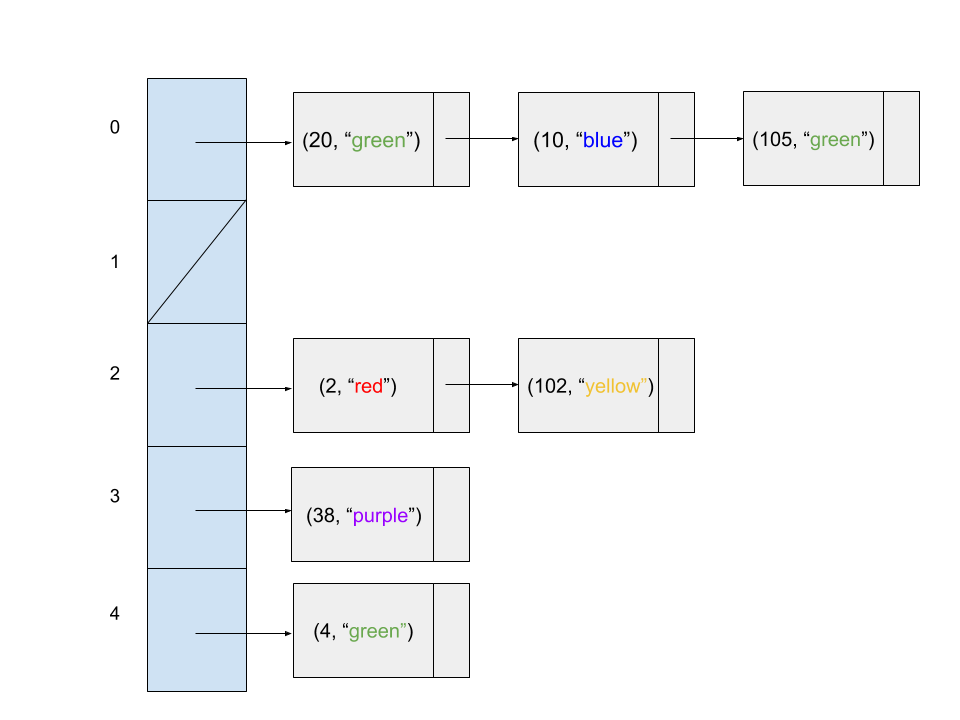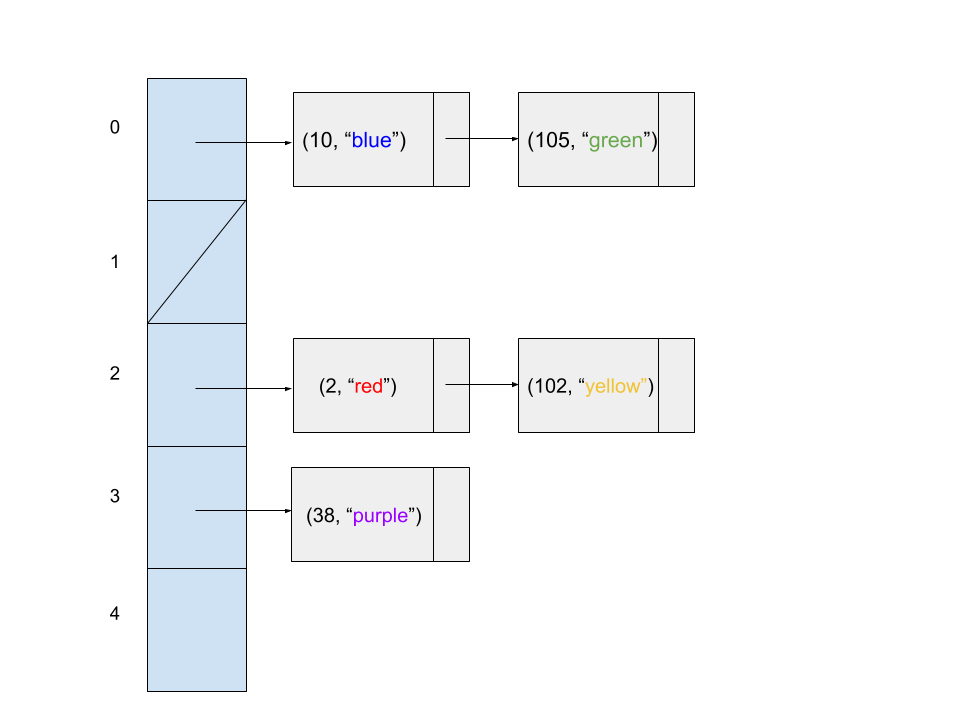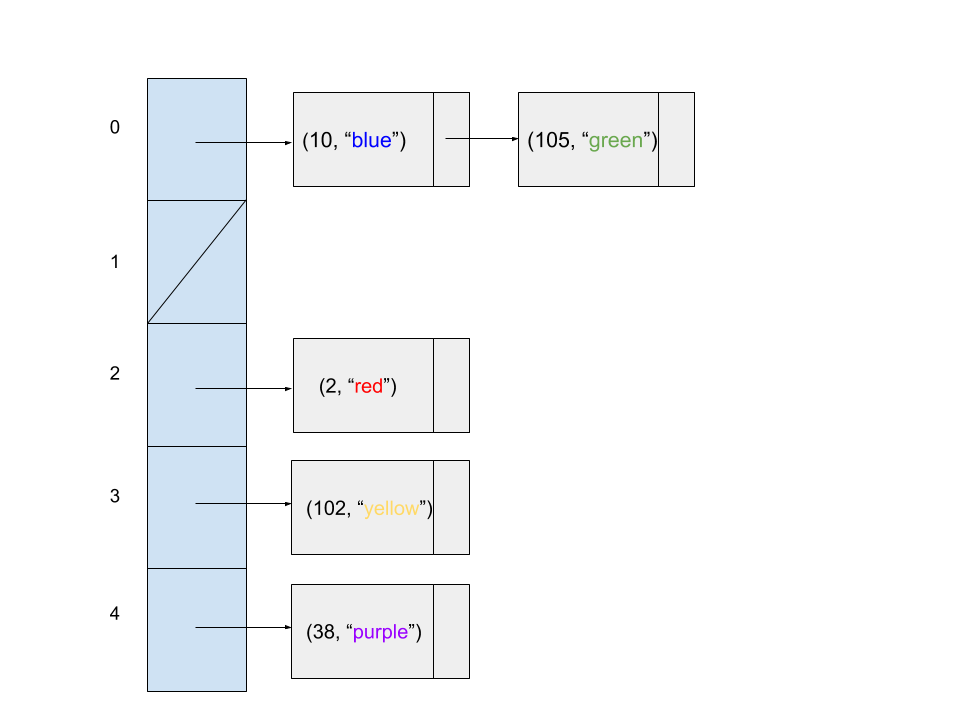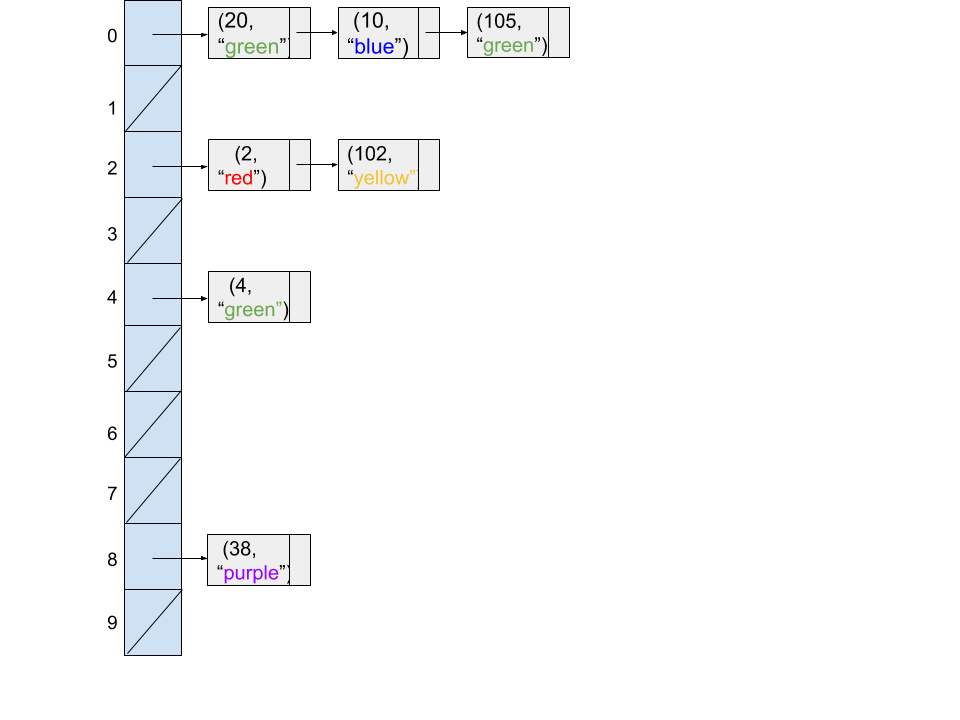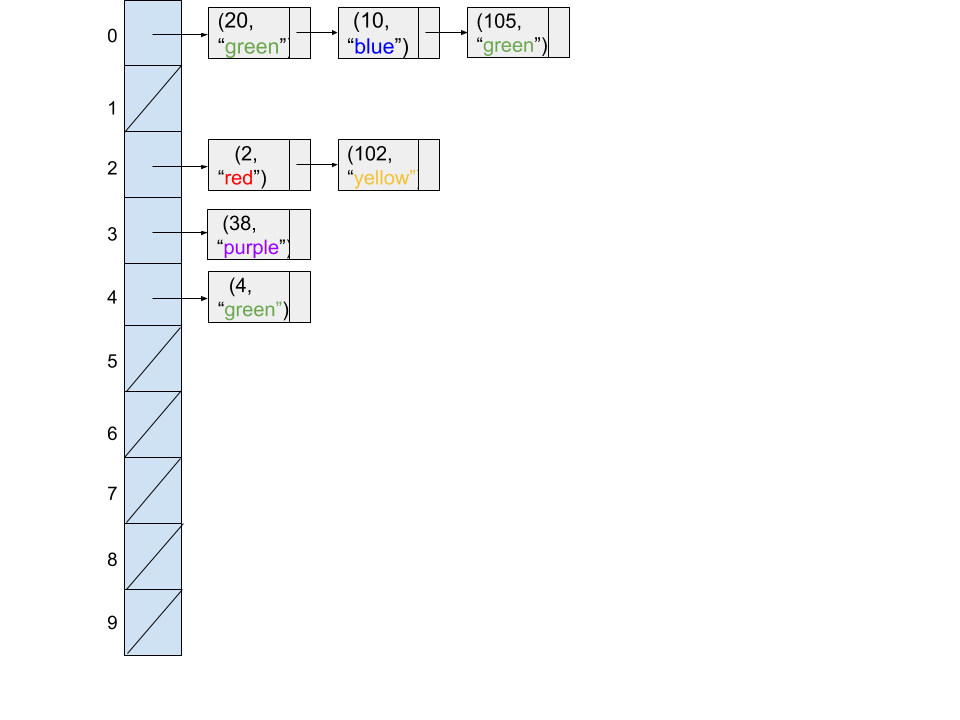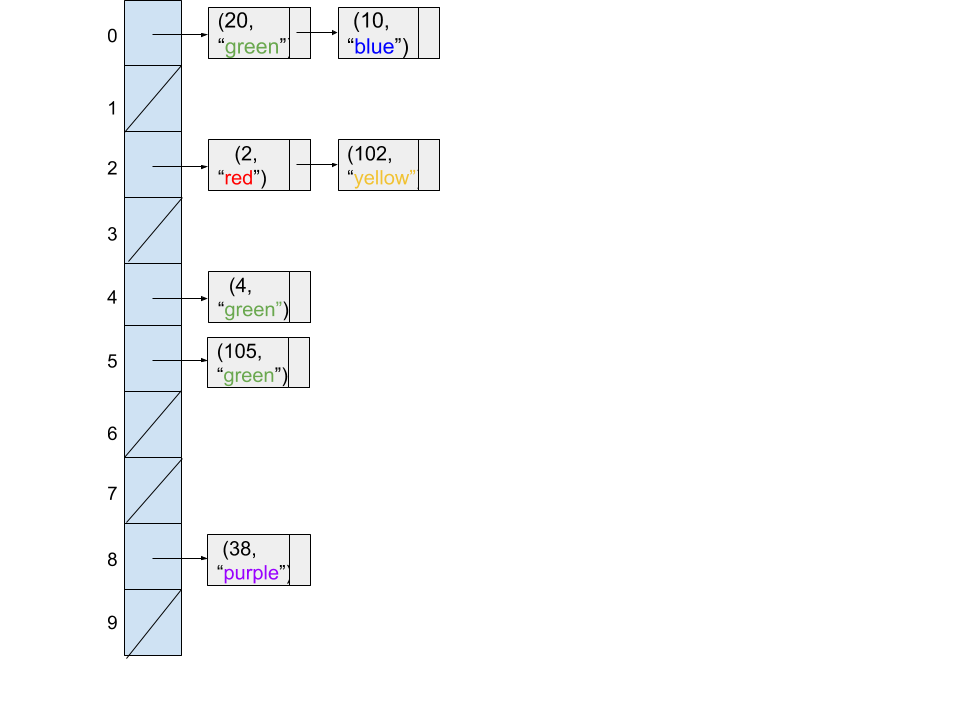Hash Tables
Table of contents
- Arrays
- DataIndexedIntegerSet
- Collisions
- DataIndexedStringSet
- Hash tables
- Separate chaining
- Hash table analysis
- Hash table insertion
- Hash functions
- LLRB tree buckets
Arrays
Balanced search tree and binary heap data structures guarantee that the height of the tree will be roughly logarithmic with respect to its total size, resulting in tree operations such as search and insertion only taking logarithmic time. This is a massive improvement over linear search. A tree containing over 1 million elements has a height that’s within a constant factor of 20!
How can we do even better than a balanced search tree? Java’s TreeSet and TreeMap classes are represented as red-black trees. In this lesson, we’ll examine hash tables, the data structure behind Java HashSet and HashMap, which can have constant time search and insertion—regardless of whether your hash table contains 1 million, 1 billion, 1 trillion, or even more elements.
- Contiguous memory arrays
- Arrays are stored contiguously in memory where each array index is next to each other, one after the other. Unlike a linked list, arrays do not need to follow references randomly throughout memory. Indexing into an array is a constant-time operation as a result.
The DataIndexedIntegerSet uses this idea of an array to implement a set of integers. It maintains a boolean[] present of length 2 billion, one index for almost every non-negative integer. The boolean value stored at each index present[x] represents whether or not the integer x is in the set.
void add(int x)- Adds
xto the set by assigningpresent[x] = true. boolean contains(int x)- Returns the value of
present[x]. void remove(int x)- Removes
xfrom the set by assigningpresent[x] = false.
public class DataIndexedIntegerSet {
private boolean[] present;
public DataIndexedIntegerSet() {
present = new boolean[2000000000];
}
public void add(int x) {
present[x] = true;
}
public boolean contains(int x) {
return present[x];
}
public void remove(int x) {
present[x] = false;
}
}
While this implementation is simple and fast, it takes a ton of memory to store the 2-billion length present array—and it doesn’t even work with negative integers! Additionally, we’ll also need to come up with a way to generalize this idea so that it works with other data types such as strings.
Let’s focus on the second problem. Say we want to add “cat” to an array-based set of strings. One way to determine where to store “cat” is to use the first character ‘c’ to determine the array index. We can store words with first character ‘a’ at index 1, ‘b’ at index 2, ‘c’ at index 3, etc.
Give an example where this idea doesn't work as expected.
There are many words that start with the character ‘c’! After adding “cat” to the set, contains("chupacabra") will also return true even though the client never called add("chupacabra").
DataIndexedIntegerSet
Collisions
A collision occurs when two or more keys share the same index. One way we can avoid collisions is to be more careful about how we assign each English word. If we make sure every English word has its own unique integer index, then we won’t run into collisions!
Suppose the string “a” goes to 1, “b” goes to 2, “c” goes to 3, …, and “z” goes to 26. Then the string “aa” should go to 27 since (1 ⋅ 261) + (1 ⋅ 260) = 27, “ab” to 28, “ac” to 29, and so forth. Since there are 26 lowercase English characters, our base is 26.
Generalizing this pattern, we can compute the index for “cat” as (3 ⋅ 262) + (1 ⋅ 261) + (20 ⋅ 260) = 2074. This mathematical formula is known as a hash function. The result of applying this hash function to the string “cat” is the hash value 2074.
- Hash function
- Returns an integer representation of a given object called its hash code.
So long as we pick a base that’s at least 26, this hash function is guaranteed to assign each lowercase English word a unique integer. But it doesn’t work with uppercase characters or punctuation. If we want to support other languages than English, we’ll need an even larger base. For example, there are 40,959 characters in the Chinese language alone. A char in Java supports all of these characters and more: to support all strings, the base would need to be 216.
To make matters worse, the maximum size of an array in Java is limited to the size of the largest Java int, which is 2,147,483,647. There are more unique strings than there are unique Java int values, so collisions are inevitable!
Question 1
Compute the hash code for “bee” using the hash function above.
Explanation
Since the character ‘b’ is the second letter in the alphabet and ‘e’ is the fifth, we get (2 ⋅ 262) + (5 ⋅ 261) + (5 ⋅ 260) = 1487.
DataIndexedStringSet
Hash tables
Separate chaining
Hash tables improve upon data-indexed arrays by handling collisions. We’ll primarily study separate chaining hash tables, though there are other ways of handling collisions.
- Separate chaining
- A strategy for handling collisions that replaces the
boolean[] presentwith an array of “buckets” where each bucket starts empty. For adding an itemxthat belongs at indexh, addxto bucketh. To avoid duplicates (as required by the set and map ADTs), only addxif it is not already present in the bucket.
Since separate chaining addresses collisions, we can now use smaller arrays. Instead of directly using the hash code as the index into the array, take the modulus of the hash code to compute an index into the array.
Separate chaining comes with a cost. The worst-case runtime for adding, removing, or finding an item is now in Θ(Q) where Q is the size of the largest bucket. Consider how we might implement contains: rather than just returning the true/false boolean value, we’ll need to search through the bucket. The runtime of a separate chaining hash table is affected by the bucket data structure.
contains(Object o)- Compute the hash code of
omodulo the length of the array to get the bucket index. Then, search the bucket by callingequalson each item.
Hash table analysis
Hash table insertion
Consider the following code snippet.
Map<Integer, String> map = new HashMap<>();
map.put(20, "green");
map.put(2, "red");
map.put(10, "blue");
map.put(4, "green");
map.put(105, "green");
map.put(102, "yellow");
map.put(38, "purple");
Question 1
Assuming the HashMap does not resize and its underlying array is fixed at 5 buckets, which of the following diagrams might represent the state of the hash table at the end of the code snippet?
Question 2
Assuming the HashMap resizes its underlying array when the number of items equals the number of buckets by doubling the number of buckets (from 5 buckets to 10 buckets), which of the following diagrams might represent the state of the hash table at the end of the code snippet?
Hash functions
How does a Java HashSet or HashMap know how to compute each object’s hash code? Unlike search trees that relied on the Comparable interface, Java provides a default hash function implementation. All objects in Java provide a default implementation of the following two methods.
boolean equals(Object o)- Returns true if
ois considered equal to this object. The default implementation checks thatthis == o. int hashCode()- Returns the hash code for this object. The default implementation returns the memory address for this object.
The Java documentation for Object.hashCode describes the hashCode contract. When overriding the equals method, it is usual necessary to override the hashCode method so that it is consistent with equals.
Question 1
True/false: Suppose we have a Dog class where each Dog has a name and a weight. What must the code output if we want the Dog class to work in a hash table?
Dog d1 = new Dog("Zeus", 5);
Dog d2 = new Dog("Zeus", 5);
// d1.equals(d2) evaluates to true!
System.out.println(d1.hashCode() == d2.hashCode());
Explanation
If any two objects are equal, then they must also have the same exact hash code. Otherwise, if they do not have the same hash code, then they might not go to the same bucket in the hash table.
Question 2
Suppose the Dog class overrides equals but not hashCode. What could happen if we run the following code?
Dog d1 = new Dog("Zeus", 5);
Dog d2 = new Dog("Zeus", 5);
// d1.equals(d2) evaluates to true!
Set<Dog> dogs = new HashSet<>();
dogs.add(d1);
System.out.println(dogs.contains(d2));
d1andd2will always have the samehashCode.d1andd2may have the samehashCode.d1andd2will have only a tiny chance of having the samehashCode.- The print statement will always print false.
- The print statement will always print true.
- The print statement will sometimes print false and sometimes print true.
Explanation
d1 and d2 will not have the same hashCode since they are separate objects in memory. However, even though their hash codes will not directly collide, because the hash table computes the bucket index by taking the modulo of the hash code, it’s possible that they might just coincidentally happen to fall into the same bucket even though they have different hash codes.
Question 3
True/false: Suppose the Dog class overrides hashCode but not equals. Will the following hashCode work in a hash table?
public int hashCode() {
return 17;
}
Explanation
While this hash function technically works, all objects will go to the same bucket.
Question 4
ArrayList provides valid and effective implementations for equals and hashCode. Why might we still caution storing ArrayList objects in a HashSet, i.e. HashSet<ArrayList<String>>?
- In a hash table, each bucket is a list of items, and you can’t store a list in a list.
- A list can be changed after its creation, so if one of the lists changes, it can get lost in the hash table.
- Lists can be potentially infinitely large but integer hash codes are finite, so collisions are very likely.
LLRB tree buckets
We know that the worst-case runtimes for separate chaining hash table operations are closely related to the size of the largest bucket. In the hash table analysis, we compared hash tables without resizing (fixed number of buckets) versus hash tables with resizing.
- Hash tables without resizing
- The number of buckets is constant, so the size of the largest bucket is in Θ(N) with respect to N, the total size of the hash table.
- Hash tables with resizing
- The number of buckets grows linearly with respect to N. Assuming elements are evenly spread across the buckets, then the size of the largest bucket is in Θ(1).
In reality, Java HashSet and HashMap include a special optimization for avoiding worst-case runtime. When a linked list bucket grows contains more than 8 elements, the bucket will be converted into a left-leaning red-black tree. While this optimization does not affect the size of the largest bucket, it might improve the runtime.
For these problems, do not assume elements are evenly spread across the buckets.
Question 1
Consider a hash table without resizing but using LLRB trees as the bucket data structure. Identify the worst-case runtime for inserting an element into this hash table with respect to N, the total size of the hash table.
- Θ(1)
- Θ(log N)
- Θ(N)
- Θ(Nlog N)
- Θ(N2)
Explanation
In the worst-case, all elements go to the same bucket. Thus, inserting into this hash table follows the same analysis as the worst-case for inserting into an LLRB tree.
Question 2
Consider a hash table with resizing but using LLRB trees as the bucket data structure. Identify the worst-case runtime for inserting an element into this hash table with respect to N, the total size of the hash table.
- Θ(1)
- Θ(log N)
- Θ(N)
- Θ(Nlog N)
- Θ(N2)
Explanation
In the worst-case, all elements go to the same bucket and the insertion triggers a resize operation! Thus, inserting into this hash table follows the same analysis as the worst-case for inserting all N items into an LLRB tree.
Question 2
Consider a hash table with resizing but using LLRB trees as the bucket data structure. Identify the worst-case runtime for inserting an element into this hash table with respect to N, the total size of the hash table.
- Θ(1)
- Θ(log N)
- Θ(N)
- Θ(Nlog N)
- Θ(N2)
Explanation
In the worst-case, all elements go to the same bucket and the insertion triggers a resize operation! Thus, inserting into this hash table follows the same analysis as the worst-case for inserting all N items into an LLRB tree.
Question 3
A team member points out that this idea doesn’t actually help with the worst-case runtime for hash tables with resizing, so we shouldn’t use this idea. Do you agree with their assessment? Why might the Java developers implement this optimization in spite of the absolute worst-case runtime?
